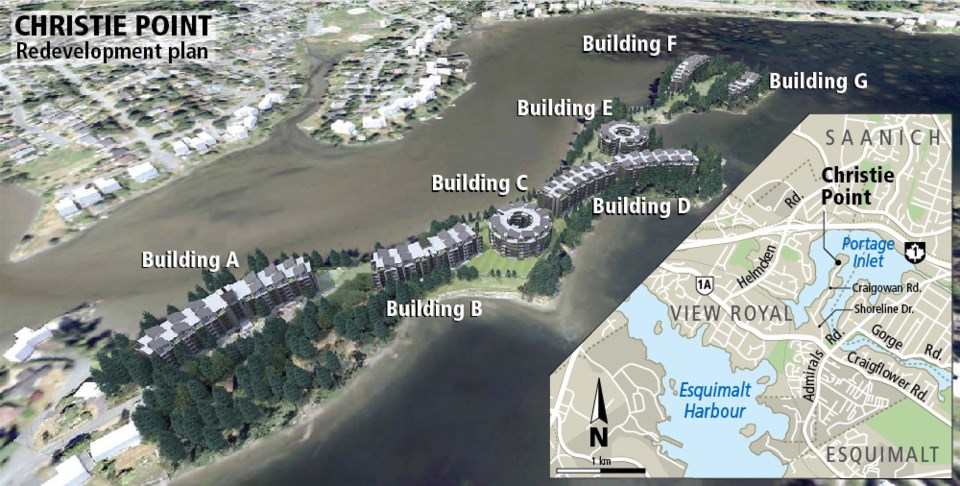View Royal Council has voted 3-2 to rezone Christie Point, clearing the way for a $200 million development that would demolish 161 apartments in two-storey buildings from the 1960s and replace them with 473 new ones in mostly six-storey buildings.
Council’s vote on the proposal by Realstar Group of Toronto came after 15 minutes of back and forth, a week after a public hearing of nearly six hours on the largest housing project in View Royal history. Voting in favour were councillors Aaron Weisgerber and Ron Mattson; against were councillors Heidi Rast and John Rogers, who spoke at length about the drawbacks of the proposal.
The deciding vote was cast by Mayor David Screech, who said Realstar’s improved offer to tenants and the company’s decision to phase in development and grandfather in 33 units for current residents at existing rents, influenced his reasoning. “I have never had a lot of difficulty with the six storeys,” he said, explaining that the capital region is in a rental housing crisis that requires higher densities, and the plan for Christie Point is appropriate.
Rogers said he would have gladly supported the project elsewhere but fears it will “stand out like a sore thumb” in such a jewel-like setting. “Six storeys is not compatible with the ambiance or the character” of the area, Rogers said. He expects far more than the planned 20 trees will be lost and even the 500 new trees the developer will plant will not screen the buildings on the site.
But the status quo is not a viable option, Mattson said, with the tenants’ package “probably the best deal I as a councillor could get for the residents.”
“I know it’s been a tough haul and divisive within the community,” Screech said.
Opponents say the proposal is too dense, too tall and too intrusive for the sensitive environment of the kilometre-long peninsula on Portage Inlet that has been a federal bird sanctuary since 1923. But Screech said he thinks the proposal will improve environmental considerations.
“I don’t think he knows what he’s talking about,” said Doug Critchley, research director of the Portage Inlet Protection Society, a property owners group with a stewardship role.
Society president George Blogg contended the development will “be like a cruise ship in the middle of a bird sanctuary” and said its skyline will be 370 metres long and show above the treeline
As people started leaving council chambers, a middle-aged man wearing a bright blue T-shirt hollered, “See you at the polls next time, buddy” — while walking toward the mayor and twice calling him “a loser” in a loud, belligerent voice.
“Get the hell out of here,” Screech responded.
Tenants, especially older ones, are fearful of how they will find accommodation in the local rental market, one of the tightest in Canada.
Pat Mills broke down outside the municipal hall, saying she and her husband and, who has Parkinson’s disease, were “renovicted” from the apartment they lived in for 16 years before they moved to Christie Point a year ago. Now, she said, she feels “demovicted” and doesn’t know where they will live, but she’s starting to look.
Realstar has committed to maintain rent rates for tenants of 10 years’ standing if they moved back to new units, something that would cover about 21 per cent of current tenants, along with other compensation and relocation help.
Judith Newnham of the Christie Point Advocates Society said her group was disappointed by the decision. She had hoped that all tenants would be able to return at the same rents they pay now and that council has the power and obligation to stipulate the number of affordable units that should be included.
Although opponents pointed to the six-storey height of several buildings in the proposal as contravening the maximum of four storeys for apartments in the Official Community Plan, RealStar said height and setbacks are among allowable variances if a proposal substantially complies with the intent of guidelines. If the proposal is reduced to four storeys, rents would go up and a lower project could not be contained to the current footprint, leading to much more pavement, RealStar has said.



